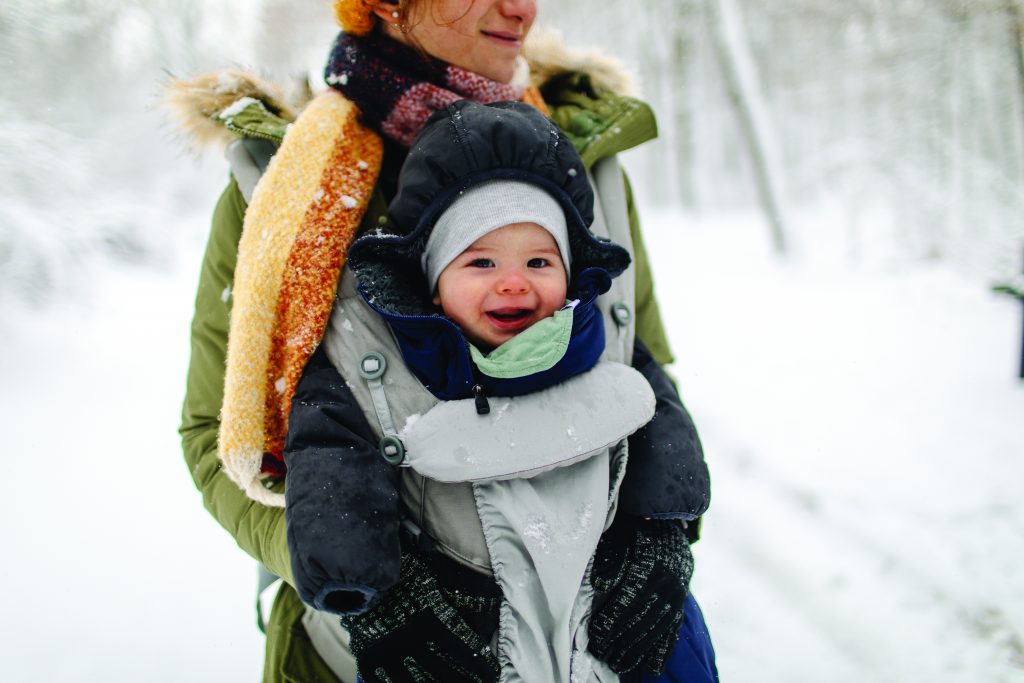
5 Ways To Care For Baby In The Winter
By Maria Bickell, BSN, RN, IBCLC, Boone Family Birthplace
Caring for a baby in the wintertime can be challenging, but knowing and taking a few precautionary measures can protect your child from problems that could arise as cold temperatures set in, both outside and indoors.
As a registered nurse with over a decade of experience in caring for mothers and babies, and as a mother myself, I’m fully aware of the sometimes overwhelming responsibilities of caring for an individual who completely depends on you. This is especially true in winter. These tips will hopefully help you protect your little one through this harsh season in Missouri.
1. Practice good hygiene for you and your baby. Proper hand hygiene can provide the best protection against viral illnesses which are common during colder months. At gatherings with family and friends, ensure that anyone who wants to hold or touch your baby has thoroughly washed their hands first. Don’t neglect your own hygiene or health, either!
2. Protect your baby’s skin. Babies have extremely sensitive skin, so it’s important to protect it from the harsh atmosphere outside and dry air indoors. Increased temperatures in the home can make the air and your baby’s skin drier. Consider using a humidifier. Applying unscented lotion to baby’s moistened skin following a bath can also help. Daily water baths are typically fine but keep bath time short and don’t use harsh soaps unless absolutely necessary. Keep the room temperature between the bathroom and bedroom balanced.
3. Dress your baby for warmth and safety. Adequate clothing is essential when baby goes outside, but take care to avoid overheating or constriction. Going outside for a short time is fine as long as the temperature or wind chill are not extreme, like negative temperatures. Refrain from letting your baby play in the snow if they’re younger than a year old. Cover your baby from head to toe and layer in threes – start with a lightweight, soft base followed by a middle, slightly heavier layer, then add a water and wind-resistant top layer. Consider mittens instead of gloves. Make sure your baby has a hat that covers their ears. One of the most accurate locations to check your baby’s temperature is on the back, or nape, of the neck. When transporting your baby by car, it is extremely important to remove bulky layers, like a coat or bunting, before you buckle them into the car seat. To keep your baby warm in the car seat, you can use a blanket (or the coat as a blanket), laying it over the seat straps or harness.
4. Practice safe sleeping. It’s important to avoid excessively heating your baby or their room. Excessive sweating can cause rashes, and overheating puts an infant at higher risk for Sudden Infant Death Syndrome, or SIDS. The best room temperature is between 68 and 72°F. Dress your baby in clothing that covers their extremities. You probably don’t need to dress your baby in layers unless the sleeping area is drafty. Avoid loose bedding or blankets in the crib – if you need an extra layer to keep your baby warm, consider a sleep sack instead.
5. Give your baby an immune boost. Stay up to date on your child’s vaccinations, and don’t stop breastfeeding. Both will help boost your baby’s immunity, so they will have better defenses if they’re exposed to illnesses. Don’t hesitate to contact your baby’s